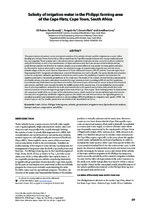| dc.contributor.author | Aza-Gnandji, Ruben C.D. | |
| dc.contributor.author | Xu, Yongxin | |
| dc.contributor.author | Raitt, Lincoln | |
| dc.contributor.author | Levy, Jonathan | |
| dc.date.accessioned | 2013-09-11T12:38:18Z | |
| dc.date.available | 2013-09-11T12:38:18Z | |
| dc.date.issued | 2013 | |
| dc.identifier.citation | Aza-Gnandji, R.C.D., et al. (2013). Salinity of irrigation water in the Philippi farming area of the Cape Flats, Cape Town, South Africa. Water SA, 39(2): 199-210 | en_US |
| dc.identifier.issn | 0378-4738 | |
| dc.identifier.uri | http://hdl.handle.net/10566/709 | |
| dc.description.abstract | This paper explores the nature, source and spatial variation of the salinity of water used for irrigation in a coastal urban farming area in Cape Town, South Africa, where water from the Cape Flats aquifer is drawn into storage ponds and used for crop irrigation. Water samples were collected in summer and winter from selected sites across the study area and were analysed for salinity as well as for concentrations of major and minor ions. Each site consists of one borehole and one pond. Isotope analysis was done for the summer samples so as to assess effects of evaporation on water quality and salinity. Descriptive statistics were used to compare the variation in range of concentration of specific ions with the recommended ranges set by the South African Department of Water Affairs and Forestry (DWAF) and the Food and Agriculture Organisation (FAO). Geographical information system (GIS) analysis was used to describe the spatial distribution of salinity across the study area, and hydro-geochemical analysis was used to assess the possibility of seawater intrusion into the aquifer system and to characterise groundwater in the study area. The results of the research showed that the concentrations of chloride, nitrate, potassium and sodium exceeded the target maximum limit according to DWAF and FAO guidelines. Groundwater and pond water were also observed to be brackish in most parts of the research area in terms of total dissolved salts content, and fresh water was only found in the middle section of the research area. It is concluded that the accumulation of salts in groundwater and soil in the study area is mainly due to the agricultural activities and partially due to the natural movement of water through the geological formation of the Cape Flats region. These findings permit the formulation of a conceptual model of the occurrence of the salinization process, which implies that the groundwater and pond water in the study area are generally suitable for irrigation purposes, but need to be used with caution as the vegetables grown are classified as sensitive and moderately sensitive to salt according to DWAF guidelines for irrigation water quality (1996). The research paves a way for possible quantitative simulation of salt mass balance in future. | en_US |
| dc.language.iso | en | en_US |
| dc.publisher | Water Research Commission | en_US |
| dc.rights | © 2013 Water Research Commission. This file may be freely used provided that the source is acknowledged. No commercial distribution of this text is permitted. | |
| dc.source.uri | http://dx.doi.org/10.4314/wsa.v39i2.3 | |
| dc.subject | South Africa | en_US |
| dc.subject | Philippi farming area | en_US |
| dc.subject | Salinity | en_US |
| dc.subject | Groundwater | en_US |
| dc.subject | Irrigation water | en_US |
| dc.subject | Hydrochemical analysis | en_US |
| dc.subject | Isotopic analyses | en_US |
| dc.subject | Evaporation | en_US |
| dc.subject | Suitability | en_US |
| dc.title | Salinity of irrigation water in the Philippi farming area of the Cape Flats, Cape Town, South Africa | en_US |
| dc.type | Article | en_US |
| dc.privacy.showsubmitter | false | |
| dc.status.ispeerreviewed | true | |
| dc.description.accreditation | Web of Science | en_US |

